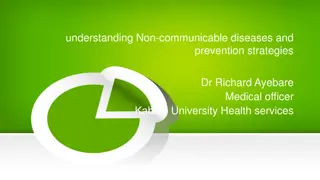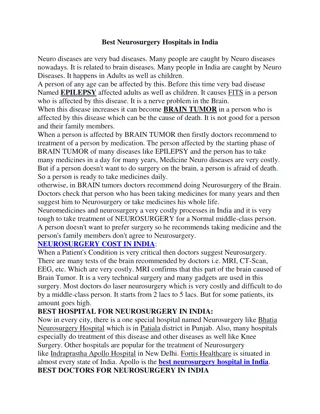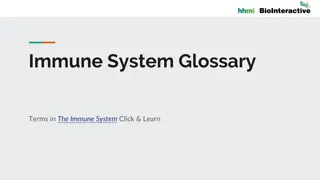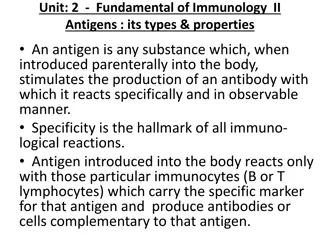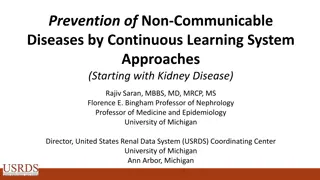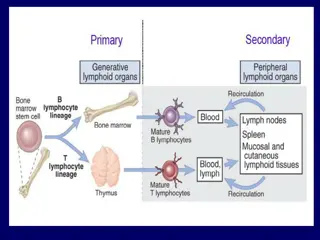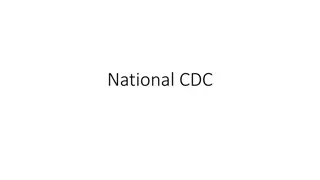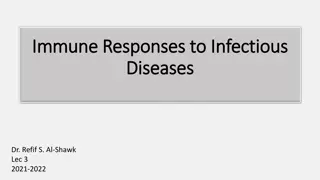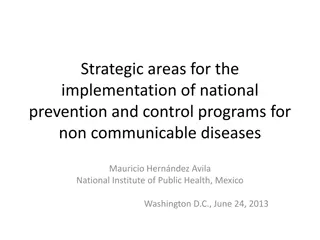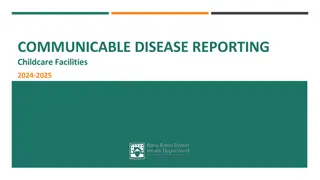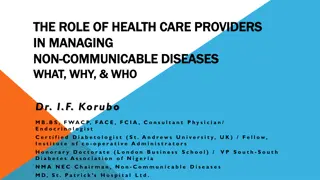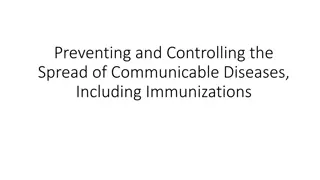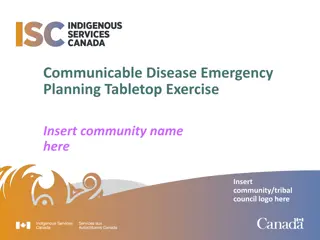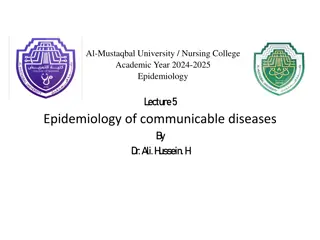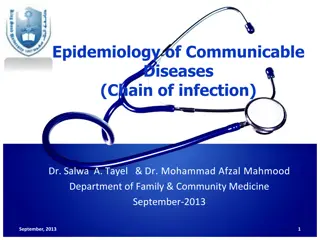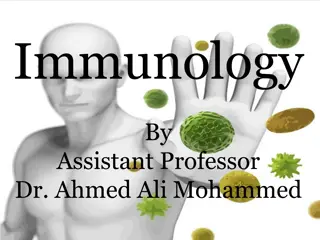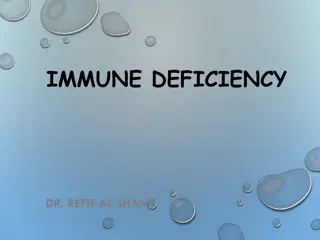
Understanding Communicable Diseases and Immune System Defense Mechanisms
Explore the causes, transmission, and prevention of communicable diseases, along with the immune system's defenses against pathogens. Learn about different types of pathogens and their effects on animals and plants, as well as how they harm tissues and produce toxins. Discover the means of transmission for animal and plant pathogens, and delve into the primary non-specific defenses in animals against pathogens.
Download Presentation

Please find below an Image/Link to download the presentation.
The content on the website is provided AS IS for your information and personal use only. It may not be sold, licensed, or shared on other websites without obtaining consent from the author. If you encounter any issues during the download, it is possible that the publisher has removed the file from their server.
You are allowed to download the files provided on this website for personal or commercial use, subject to the condition that they are used lawfully. All files are the property of their respective owners.
The content on the website is provided AS IS for your information and personal use only. It may not be sold, licensed, or shared on other websites without obtaining consent from the author.
E N D
Presentation Transcript
Communicable diseases, disease prevention and the immune system
What is a communicable disease? A disease which is caused by a pathogen Pathogens include bacteria, viruses, fungi, protozoa Measles Gangrene Alzheimer s Coronary Heart Disease Potato Blight Malaria
How Pathogens Cause Harm Damage the tissues Produces Toxins This is caused by pathogens entering cells and destroying them. They may use the cell to provide raw materials to make new copies of themselves These can act as inhibitors to enzymes or other processes that use proteins such as the protein receptors in a synapse The toxins are often by- products of bacterial reactions This then disrupts the normal cell activity of the organism
The different types of pathogen that can cause communicable diseases in plants and animals Bacteria tuberculosis (TB) bacterial meningitis ring rot (potatoes tomatoes) Virus HIV/AIDS (human), influenza (animals) Tobacco Mosaic Virus (plants) Fungi black sigatoka (bananas), ring worm (cattle), athlete s foot (humans). Protoctista Malaria potato/tomato late blight PAGES 302-310
The means of transmission of animal and plant communicable pathogens To include direct and indirect transmission, reference to vectors, spores and living conditions e.g. climate, social factors (no detail of the symptoms of specific diseases is required). PAGES 305- 314
Independent Study Read through these section and take any useful notes. Do the summary questions on page 310. You will be expected to apply your understanding to some past paper questions in next week s lessons
Learning Objectives the primary non-specific defences against pathogens in animals Non-specific defences to include skin, blood clotting, wound repair, inflammation, expulsive reflexes and mucous membranes the structure and mode of action of phagocytes To include neutrophils and antigen-presenting cells AND the roles of cytokines, opsonins, phagosomes and lysosomes.
Immunity Immunity Non-specific system Specific system Non-specific system Specific system Barriers Barriers Cells Cells Lymphocytes Phagocytes Mast cells Lymphocytes Phagocytes Mast cells Humoral Cell mediated Neutrophils Macrophages T Lymphocytes B Lymphocytes Neutrophils Macrophages T Lymphocytes B Lymphocytes Helper Killer Suppressor Helper Killer Suppressor Plasma cell Memory cell Plasma cell Memory cell Antibodies Cytokines Antibodies Cytokines
Non-specific system present from birth does not distinguish between different pathogens gives the same response each time the same pathogen attacks
Barriers Epidermis of skin (layers of dead cells) Mucous membranes (protective layer secreted by goblet cells) Chemicals such as Lysozyme in tears and urine Stomach acid
Primary defences forward_arrow_colour
Physical barriers A protective covering Maintained by blood clotting Epithelia covered in mucus Blood clotting Hydrochloric acid in the stomach
Lines of defence The body has many different lines of defence: physical and chemical barriers most most controllable pathogen-specific defences non-specific defences essential ingestion of bacteria by white cells involves antibodies and T- and B-cells inflammation to attract white cells into tissues forward_arrow_colour
What triggers an immune response? Antigens These generate an immune response These could be proteins or other molecules on the surface of cells, a molecule e.g. a toxin etc. Our cells also have proteins etc. on the surface but they are not recognised by our own personal immune system as antigens The system can tell the difference between you and non-you
Not always helpful Can you think of one type of disease, two medical instances where being able to tell you from non-you is not helpful? Blood transfusions, organ transplants, cancers
Phagocytes White blood cells (leucocytes) Continually produced from stem cells in bone marrow Stored in bone marrow Released into blood to engulf and digest foreign bodies Two types: Neutrophils and Macrophages
Neutrophils 60% of white blood cells Smaller than macrophages Numbers increase rapidly during infection Move into tissues through leaky capillary walls Short lived Chemotaxic
Neutrophil (lobed nucleus)
Macrophages 4% of white blood cells Larger than neutrophils Circulate in blood and tend to remain in organs such as lungs, spleen, kidney, lymph nodes Squeeze through leaky capillary walls Phagocytic but play a role in initiating the specific immune system Long lived
Macrophage or monocyte (bean-shaped nucleus)
Opsonins 9 proteins released by liver and phagocytes eg Imunoglobulin (Ig) IgG and IgM Normally circulate in blood in inactive state activated in presence of bacteria and yeasts Four mechanisms: 1. deposited on membrane of pathogen and make it porous 2. stimulate histamine release from mast cells 3. attract phagocytes to infection (chemotaxis) 4. opsonisation
Opsonisation One end of complement protein binds to molecules on bacterial membrane Other end binds to phagocyte As phagocyte binds to complement proteins, the bacterial cell is engulfed Phagocyte Bacterium Bacterium Complement proteins
Opsonisation or the Complement Cascade The binding of an antibody to the surface of a pathogen can set of a chain reaction with blood proteins, which... ... causes the pathogen to swell up an burst.
Mast cells Granular cells found in connective tissue are activated when an injury occurs. Release histamine 1. relaxes arterioles to increase blood flow 2. makes capillaries more leaky 3. attracts phagocytes 4. makes sensory neurones more sensitive Release cytokines. These chemicals attract phagocytes to the site of the wound which engulf and digest the pathogens. Rashes/hives are often visible during this process
Mode of action of phagocytes Complement proteins released by the liver and phagocytes help the phagocytes to recognise pathogens Phagocytes engulf bacteria (or other debris) Ingested cells are enclosed in a vacuole Lysosomes fuse with vacuole and release hydrolytic enzymes into it
Produced in bone marrow of long bones Antibodies attach to antigens on bacterium Proteins attach to antibodies Surface of bacteria coated with proteins called opsonins (opsonisation) Complement proteins from bacteria are attractant. Neutrophils attach to opsonins Neutrophils engulf bacterium into phagosome Lysosomes fuse with phagosome Forming a phagolysosome Enzymes released Soluble products absorbed
Phagocytes a secondary defence Examiners tip: Phagocytes don t eat microorganisms, they engulf and ingest them! Neutrophils Macrophages Draw diagram and explain role of: Phagosome Lysosomes Antigens Antibodies Receptors
Phagocytosis Relatively quick for neutrophils(about 10 minutes) Macrophages add another step They become antigen presenting cells (APC) They combine the antigens from the pathogen with a glycoprotein from the macrophage Major Histocompatability Complexes (MHC ) These are positioned on the cell surface membrane to signal to the lymphocytes Lymphocytes are part of the specific immune response which learns the antigens of the pathogen so that it can respond to it directly next time.
MHC = Major Histocompatability Complex Lymphocyte
Cellular processes involved in phagocytosis This process can be linked to other areas of the course Role of the cytoskeleton in moving the phagocyte- formation of the pseudopodia. Role of the cytoskeleton in moving the lysosomes towards the phagosome. Cell signalling using cytokines and MHC. Large numbers of mitochondria to provide ATP for endocytosis (engulfing the pathogen)and exocytosis when excreting the waste products. Enzyme activity involving the lytic enzymes in the lysosome.
Learning Objectives the primary non-specific defences against pathogens in animals Non-specific defences to include skin, blood clotting, wound repair, inflammation, expulsive reflexes and mucous membranes the structure and mode of action of phagocytes To include neutrophils and antigen-presenting cells AND the roles of cytokines, opsonins, phagosomes and lysosomes.

